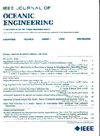视线引导:学会向前看
IF 5.3
2区 工程技术
Q1 ENGINEERING, CIVIL
引用次数: 0
摘要
本文介绍了一种利用神经网络参数化前瞻距离的视距制导方法。我们证明了所提出的导引律给出了一个包含原点一致全局渐近稳定(UGAS)的紧集。重要的是,当横向速度为零时,所提出的制导律使闭环系统的原点为UGAS。通过使用神经网络参数化前瞻距离,学习过程产生给定性能指标的局部最优前瞻距离,并允许基于任意输入的前瞻距离的非线性变化。我们演示了所提出的方法如何优于使用时变前瞻距离的几种最先进的LOS制导方案。本文章由计算机程序翻译,如有差异,请以英文原文为准。
Line-of-Sight Guidance: Learning to Look Ahead
This article introduces a novel line-of-sight (LOS) guidance approach utilizing a neural network to parameterize the lookahead distance. We prove that the proposed guidance law renders a compact set containing the origin uniformly globally asymptotically stable (UGAS) for the closed-loop system. Importantly, if the sideways velocity is zero, the proposed guidance law renders the origin of the closed-loop system UGAS. By employing a neural network to parameterize the lookahead distance, the learning process results in a locally optimal lookahead distance for a given performance metric, and allows for nonlinear variation of the lookahead distance based on arbitrary input. We demonstrate how the proposed approach outperforms several state-of-the-art LOS guidance schemes utilizing time-varying lookahead distances.
求助全文
通过发布文献求助,成功后即可免费获取论文全文。
去求助
来源期刊

IEEE Journal of Oceanic Engineering
工程技术-工程:大洋
CiteScore
9.60
自引率
12.20%
发文量
86
审稿时长
12 months
期刊介绍:
The IEEE Journal of Oceanic Engineering (ISSN 0364-9059) is the online-only quarterly publication of the IEEE Oceanic Engineering Society (IEEE OES). The scope of the Journal is the field of interest of the IEEE OES, which encompasses all aspects of science, engineering, and technology that address research, development, and operations pertaining to all bodies of water. This includes the creation of new capabilities and technologies from concept design through prototypes, testing, and operational systems to sense, explore, understand, develop, use, and responsibly manage natural resources.
 求助内容:
求助内容: 应助结果提醒方式:
应助结果提醒方式:


